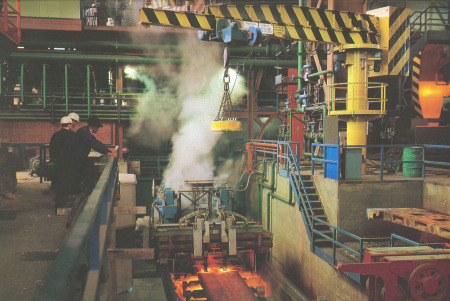VÖEST up to the Merger with Österreichisch-Alpine Montangesellschaft

The 1960s see VÖEST developing into—by Austrian standards—a huge and multifaceted conglomerate with an international sales network comprising 274 business relationships in 87 countries as early as in 1968.
The First Austrian Nationalization/Organization Act of 1963 launches the corporate reorganization of VÖEST. It is aimed at counteracting the economy’s cyclical fluctuations, concentrating the highly scattered ownership structures of the state-owned industries, and enhancing the efficiency of management and coordination. In 1963, therefore, several plants that have already been closely associated with VÖEST are integrated into the company as part of its reorganization: the Krems steelworks and Wiener Brückenbau as subsidiaries, and the Liezen plant with both mechanical engineering and foundry as a production unit. The decision is made to restructure the production program of the Krems steelworks.
Among other things, a special investment program for 1965‑68 aimed at modernizing the finishing operations, automating the rolling mills, and reducing capacities in production facilities that are stretched to the limit now and then leads to the construction of a 10,000 m³ oxygen system—the first continuous slab casting unit in LD Steelworks 2—that is started up in 1968. Moreover, LD Steelworks 2 is expanded by a sixth converter, which serves not only to boost production capacity, but also to showcase the state-of-the-art plant as proof of VÖEST’s industrial plant engineering prowess.
To enable long-term corporate planning, the Management Board resolves on February 17, 1969, to put in place planning workgroups tasked with defining the goals of both the company and its business segments and preparing a long-term action plan. The resulting “Goals and Action Plan of VÖEST for the Mid-1970s” are the first steps in the direction of this kind of general planning.
Among others, a Sendzimir cluster cold rolling mill, which is built by the mechanical engineering department under license and enables the production of very thin plate; LD Steelworks III; and the galvanizing line in Cold Rolling Mill II are started up in Linz between 1970 and 1973. The new apprentice training center also opens. The addition of the cold rolling mill brings the number of VÖEST’s cold rolling mills to a total of three with an annual total capacity of 650,000 tons of sheet steel.
On June 20, 1972, Österreichische Industrieverwaltungs-Aktiengesellschaft (ÖIAG), the Austrian stock corporation tasked with managing the equity interests of the Republic of Austria, decides to merge the Linz-based operations of VÖEST and the Vienna-based operations of Österreichisch-Alpine Montangesellschaft with the aim of boosting the efficiency of the two organizations. The merger, which elicits a lot of opposition, is made retroactive to January 1, 1973, in accordance with the relevant Federal Act of February 15, 1973.
VÖEST fears that the substantially weaker financial position of Alpine AG will cause it to incur losses, while Alpine AG, for its part, fears that it will be dominated by VÖEST. High-quality flat products, i.e. sheet steel and plate of all grades and dimensions, are manufactured in Linz from the steel produced locally, whereas semi-finished goods such as billets, slabs, and blanks as well as finished goods such as steel bars and sections, wire rods, hot-rolled steel strip, and rails are manufactured in Donawitz.
The aforementioned Federal Act also provides for the transfer of the equity interests of ÖIAG in Gebrüder Böhler & Co. AG and Schoeller-Bleckmann Stahlwerke AG, both Vienna, as an in-kind contribution to the new VÖEST-ALPINE AG effective January 1, 1973.
This creates a group consisting of a total of 103 companies that are majority-owned by VÖEST-ALPINE AG as the parent company either directly or by way of its subsidiaries. Add to that qualified minority interests in 14 companies.